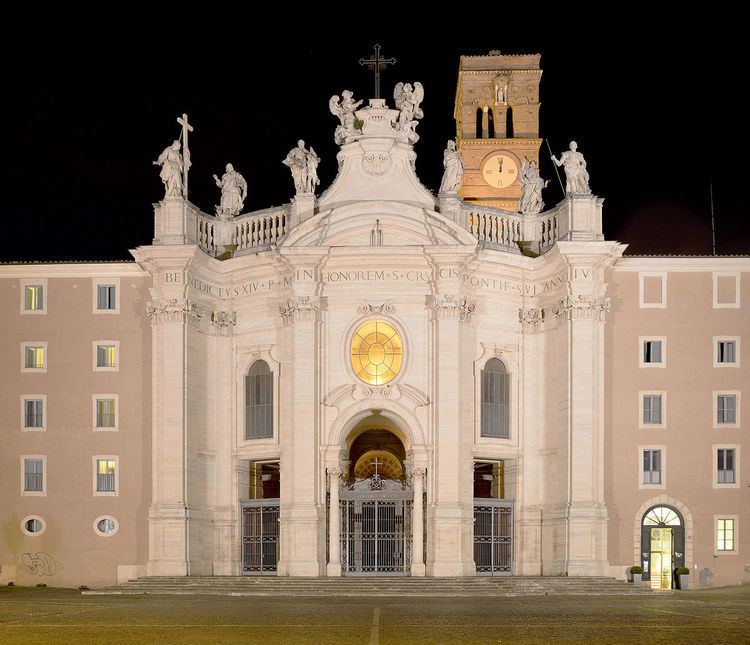Rite Latin Province Rome Architectural style Baroque architecture | District Rome Year consecrated ca. 325 Phone +39 06 7061 3053 Burials Antonietta Meo | |
 | ||
Address Piazza di S. Croce in Gerusalemme, 00185 Roma, Italy Similar Archbasilica of St John Lateran, Basilica of Saint Lawrence, Basilica of Saint Paul Outside t, Basilica of San Clemente, Santa Prassede | ||
Basilica di santa croce in gerusalemme holy cross in jerusalem
The Basilica of the Holy Cross in Jerusalem or Basilica di Santa Croce in Gerusalemme, (Latin: Basilica Sanctae Crucis in Hierusalem) is a Roman Catholic minor basilica and titular church in rione Esquilino, Rome, Italy. It is one of the Seven Pilgrim Churches of Rome.
Contents
- Basilica di santa croce in gerusalemme holy cross in jerusalem
- Le reliquie della santa croce in gerusalemme
- History
- 21st Century
- Relics of the Passion of the Lord
- Chapel of St Empress Helena
- Other Art
- References
According to tradition, the basilica was consecrated circa 325 to house the relics of the Passion of Jesus Christ brought to Rome from the Holy Land by Empress St. Helena, mother of Roman Emperor Constantine I. At that time, the Basilica's floor was covered with soil from Jerusalem, thus acquiring the title in Hierusalem; it is not dedicated to the Holy Cross which is in Jerusalem, but the Basilica itself is "in Jerusalem" in the sense that a "piece" of Jerusalem was moved to Rome for its foundation. The current Cardinal Priest of the Titulus S. Crucis in Hierusalem is Miloslav Vlk.
Le reliquie della santa croce in gerusalemme
History
At one time the site of the temple of El Gabal, or Sol Invictus, the god of Emperor Elagabalus, the Basilica was later built around a room in Empress St. Helena's imperial palace, the Palazzo Sessoriano, which she converted into a chapel circa AD 320. Some decades later, the chapel was converted into a basilica, called the Heleniana or Sessoriana. After falling into neglect, the Pope Lucius II (1144-5) restored the Basilica. It assumed a Romanesque appearance, with a nave, two aisles, belfry, and porch.
The Basilica was also modified in the 16th century, but it assumed its current Baroque appearance under Pope Benedict XIV (1740–58), who had been its titular prior to his elevation to the Papacy. New streets were also opened to connect the Basilica to two other Roman major basilicas, namely, San Giovanni in Laterano and Santa Maria Maggiore. The façade of the Basilica, which was designed by Pietro Passalacqua and Domenico Gregorini, shares the typical late Roman Baroque style of these other basilicas.
21st Century
In May 2011, the Cistercian abbey linked to the Basilica was suppressed by a decree of the Congregation for Institutes of Consecrated Life and Societies of Apostolic Life, following the results of an apostolic visitation prompted by years of serious problems, including significant liturgical disputes. According to a Vatican spokesman, "an inquiry found evidence of liturgical and financial irregularities as well as lifestyles that were probably not in keeping with that of a monk." According to Il Messaggero, Simone Fioraso, an abbot described as a "flamboyant former Milan fashion designer", "transformed the church, renovating its crumbling interior and opening a hotel, holding regular concerts, a televised bible-reading marathon and regularly attracting celebrity visitors with an unconventional approach."
Relics of the Passion of the Lord
Several famous relics of disputed authenticity are housed in the Cappella delle Reliquie, built in 1930 by architect Florestano Di Fausto, including part of the Elogium or Titulus Crucis, i.e. the panel which was hung on Christ's Cross (generally either ignored by scholars or considered to be a mediaeval forgery); two thorns of the Crown of Thorns; part of a nail; and three small wooden pieces of the True Cross. A much larger piece of the True Cross was taken from the Basilica on the instructions of Pope Urban VIII in 1629 to St. Peter's Basilica, where it is kept near the colossal statue of St. Empress Helena sculpted by Andrea Bolgi in 1639.
Chapel of St. Empress Helena
The relics were once in the ancient St. Helena's Chapel, which is partly subterranean. Here the founder of the Basilica had some soil from Calvary dispersed. In the vault is a mosaic designed by Melozzo da Forlì before 1485 depicting Jesus Blessing, Histories of the Cross, and various saints. The altar has a huge statue of St. Helena, which was obtained from an ancient statue of the pagan goddess Juno discovered at Ostia.
Other Art
The apse of the Basilica includes frescoes telling the Legends of the True Cross, attributed to Melozzo, Antoniazzo Romano, and Marco Palmezzano. The Museum of the Basilica houses a mosaic icon from the 14th century which, according to the legend, Pope Gregory I had made after a vision of Christ. Notable also is the tomb of Cardinal Francisco de los Ángeles Quiñones sculpted by Jacopo Sansovino in 1536.
Peter Paul Rubens, who had arrived in Rome by way of Mantua in 1601, was commissioned by Archduke Albert of Austria to paint an altarpiece with three panels for the Chapel of St. Helena. Two of these paintings, St. Helena with the True Cross and The Mocking of Christ, are now in Grasse, France. The third, The Elevation of the Cross, was lost. Before his marriage, the Archduke had been made a cardinal in the Basilica.
